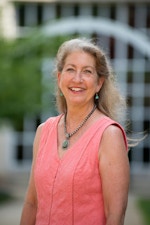Dr. Kyle Ciani

- About
- Education
- Awards & Honors
- Research
Biography
Professor Ciani specializes in the histories of women and gender across the Americas, with a focus on social justice issues. Her publications examine the advocacy involved in securing resources, such as childcare and education, to make waged labor available to women workers. She is a Core Faculty member for the Women's, Gender & Sexuality Studies (WGSS) program and is the History Department's liaison to the Honors Program. Ciani is involved with efforts by museum professionals to diversify exhibition spaces, which has included the National Women's History Museum Congressional Commission and the committee that secured the Belmont-Paul Women's Equality National Monument as a National Park Site. She is currently a member of the Sharing Stories 1977 National External Advisory Committee, which is a NEH-funded Digital History Project to collect the histories of delegates and alternates at the 1977 National Women’s Conference. She also works with K-12 educators on strategies to better integrate the histories of women and girls into K-12 curricula. Ciani's service beyond ISU includes the CARES Committee for the Western History Association, the Voting Rights Committee for the McLean County League of Women Voters, advocacy for McLean County's YWCA, and the School Street Food Pantry.
Current Courses
135.005History Of The United States To 1865
261.001History of Women in the United States To 1865
301.001Honors Thesis
299.001Independent Honor Study
499.005Independent Research For The Master's Thesis
300.002Senior Seminar In History
135.001History Of The United States To 1865
Teaching Interests & Areas
Histories of Women & Gender in the Americas; American Family; Women's Activism in the Americas.
Research Interests & Areas
In her book, Choosing to Care: One Hundred Years of Childcare and Social Reform in San Diego, 1850-1950 (University of Nebraska Press, 2019), Ciani assessed how the changing culture of work in southwestern transborder communities directed childcare strategies and policy formation. Her current research project is an examination of educational developments in the southwestern United States during the 20th century, including the introduction of public schools on reservations and efforts to rehabilitate adolescents judged delinquent by the court system.
Ph D History of Women & Gender
MA History
BA History
Influential and Inspirational History/Social Sciences Education Faculty Member
Influential & Inspirational History/Social Sciences Education Faculty
Influential & Inspirational History/Social Sciences Education Faculty
Outstanding Service (Humanities)
Leaguer of the Year
Impact Award
Impact Award
David A. Strand Diversity Achievement Award
Stan and Sandy Rives Excellence in Undergraduate Education
University Teaching Initiative Award
Book Review
Laboratory of Deficiency: Sterilization and Confinement in California, 1900-1950s by Natalie Lira (University of California Press, 2021), Journal of San Diego History, 69:1 (2023): 122-125.
Book, Authored
Ciani, Kyle E. Choosing to Care: One Hundred Years of Childcare and Social Reform in San Diego, 1850-1950. Lincoln: University of Nebraska Press, 2019.
Book, Chapter
Kyle Ciani, "San Diego Zoo, San DIego, California," in American Tourism: Constructing a National Tradition, J. Mark Souther and Nicholas Dagen Bloom, eds. (Center for American Places at Columbia College Chicago: University of Chicago Press, 2012), 227-236.
Journal Article
“Securing Childcare during the World War II: The Case of San Diego” Women and Social Movements in the United States, 1600-2000, Vol. 26, no. 1 (Spring 2022).
https://search-alexanderstreet-com.libproxy.lib.ilstu.edu/wass
Kyle E. Ciani, “A ‘Growing Evil’ or ‘Inventive Genius’: Anglo Perceptions of Indian Life in San Diego, 1850-1900,” Southern California Quarterly, 89:3 (Fall 2007): 249-284.
Kyle E. Ciani, “Hidden Laborers: Female Day Workers in Detroit, 1870-1920,” Journal of the Gilded Age and Progressive Era 4:1 (January 2005): 23-51.
Kyle E. Ciani, “Revelations of a Reformer: Helen D. Marston Beardsley and Progressive Activism,” Journal of San Diego History 50:1/2 (Summer/Fall 2004): 102-123.
Kyle E. Ciani, “The Power of Maternal Love: Negotiating a Child’s Care in Progressive-era San Diego,” Journal of the West 41:4 (Fall 2002): 71-79.
Newspaper, Article
Kyle E. Ciani, “Putting an End to the Silence of Sexual Assault and Rape,” Gender Matters, 16:3 (February/March 2011): 1-2.